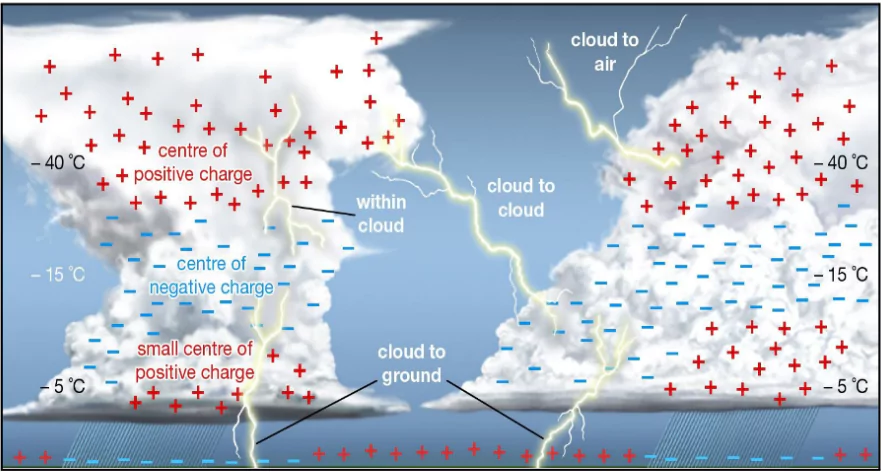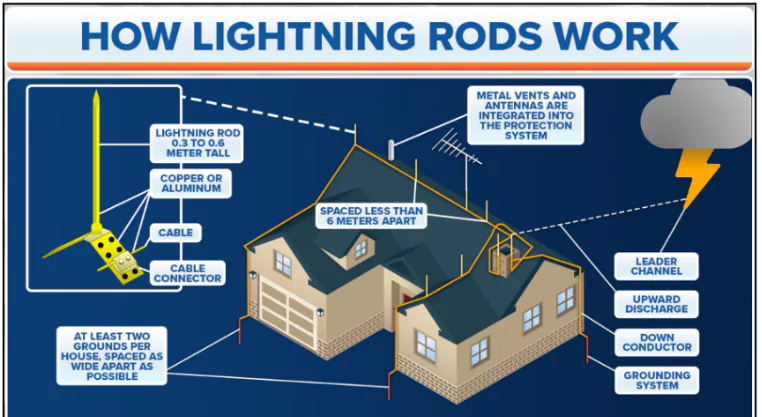Climate change is making lightning strikes around the world more common and deadlier.
Lightning Strikes in India
- Every year, around 24,000 people around the world are killed by such strikes.
- In India, lightning strikes killed 2,887 people in 2022.
- Geographical Distribution in India: Lightning frequency is highest in northeastern states and West Bengal, Sikkim, Jharkhand, Odisha, and Bihar.
- There have been petitions to declare this phenomenon a natural disaster in India so that its survivors can access institutional mechanisms for protection.
- Lightning rods are important for their ability to keep lightning away from humans.
Enroll now for UPSC Online Course
About Lightning
- Natural phenomenon formed by electrostatic discharges through the atmosphere between two electrically charged regions.
- Either both in the atmosphere or one in the atmosphere and one on the ground
- Places where lightning is more likely to strike: On raised places over earth’s surface like tall buildings or structures, trees, metallic objects, electric wires, standing animals and humans, water bodies etc.
- Because these objects provide an easy conduction path for the discharging process and hence lightning strike.
Types of Lightning
- Intra-Cloud: The most common type of lightning. It happens completely inside the cloud, jumping between different charge regions in the cloud. Intra-cloud lightning is sometimes called sheet lightning because it lights up the sky with a ‘sheet’ of light.
- Cloud to Cloud: Lightning that occurs between two or more separate clouds. Cloud to Ground: Lightning that occurs between the cloud and the ground.
- Cloud to Air: Lightning that occurs when the air around a positively charged cloud top reaches out to the negatively charged air around it.
- Bolt from the blue: A positive lightning bolt which originates within the updraft of the storm, typically 2/3rds of the way up, travels horizontally for many miles, then strikes the ground.
- Anvil Lightning: A positive lightning bolt which develops in the anvil, or top of the thunderstorm cloud, and travels generally straight down to strike the ground.
- Heat Lightning: Lightning from a thunderstorm that is too far away to be heard.
Mechanism of Lightning

- Charge Separation: Inside a cloud, air currents cause collisions between water droplets and ice particles leading to the buildup of positive and negative charges.
- This process results in a situation in which the top layer of the cloud gets positively charged while the middle layer is negatively charged.
- Electric Discharge : Electrical charges can build up in a cloud beyond the ability of air to keep resisting their movement, when air can no longer act as an insulator, and electricity flows as a sudden discharge, creating a lightning bolt.
- Thunder : Intense heat from lightning (up to 30,000°C) rapidly heats the surrounding air, causing it to expand and produce the sound we hear as thunder.
Check Out UPSC CSE Books From PW Store
Factors affecting Lightning Rate
- Rising Global Temperatures: Higher temperatures lead to more evaporation, creating more water vapour in the atmosphere, this increases the formation of storm clouds, enhancing conditions for lightning.
- Increased Atmospheric Instability : Warmer air holds more moisture, which fuels thunderstorms and associated lightning activity.
- Urbanisation: Due to Urban Heat Islands the cities often have higher temperatures than surrounding rural areas, leading to increased convection and thunderstorm activity.
- Pollution : Aerosols and Particulate Matter due to pollution can act as nuclei for water droplets, promoting cloud formation and electrical activity.
- Deforestation : Reduces the cooling effect of forests, increasing local temperatures and atmospheric instability.
About Lightning Rod

- Lightning rod is a metal rod or conductor placed on the highest point of a building or structure. It is connected to the ground through a wire or a conductive path.
- Lightning rods prevent damage from lightning strikes by safely directing the electrical energy into the ground.
Mechanism of Protection
- Charge Redistribution: Lightning rods reduce the chance of a direct strike by redistributing electrical charges in the area around the rod . This can lower the potential difference that triggers lightning.
- Direct Path for Current: If a lightning strike occurs, the rod provides a low-resistance path for the electrical energy to travel safely into the ground.
- Attraction to the Rod: Lightning seeks the shortest and most conductive path to the ground. The rod, being a pointed and conductive structure, attracts the lightning away from less conductive materials (like the building).
- Pointy and pointed things create stronger electric fields near them thus are more conductive.
Measures to reduce Impact of Lightning
- 30-30 Rule: If lightning and thunder claps are coming within 30 seconds of each other, take shelter.
- Do not leave this shelter until 30 minutes after the storm has passed.
- The best shelter is in a building or hard-topped metal vehicle.
- Avoid Electrical Conductors: Stay away from corded phones, computers, plumbing, and windows.
- Minimise Exposure: If caught outside, immediately seek shelter in a low-lying area.
- Avoid Tall Objects: Stay away from tall objects like trees, poles, and hilltops.
- Stay Dry: Avoid water bodies as water conducts electricity.
Enroll now for UPSC Online Classes
Government Initiatives to Tackle Lightning in India
- Early Warning Systems: The National Disaster Management Authority (NDMA) has developed advanced lightning early warning systems in collaboration with the Indian Meteorological Department (IMD), using Doppler Weather Radars, lightning detection networks, and satellite-based monitoring.
- The Damini app provides timely lightning alerts in multiple languages to warn the public.
- Dedicated Agencies and Protocols: NDMA coordinates lightning risk management, while the National Remote Sensing Centre under ISRO contributes with detection services.
- NDMA’s guidelines since 2019 and the Common Alert Protocol (CAP) ensure streamlined alerts across states.
- Community Awareness: The Lightning Resilient India Campaign, led by NDMA and supported by Climate Resilient Observing Systems Promotion Council (CROPC) and IMD, educates rural populations about safety practices, targeting vulnerable groups like farmers and cattle grazers.
- Awareness is raised through Gram Panchayats and various media.
- Research and Development: Ongoing R&D includes lightning resilience frameworks, High Voltage(HV) testing labs for safety standards, and studies on climate’s impact on lightning, showcasing India’s proactive research and safety measures.
- International Collaboration: India shares its lightning risk management strategies globally, with presentations at UN Disaster Risk Reduction and discussions with SAARC and G-20 nations, positioning it as a model for comprehensive lightning management.
![]() 11 Nov 2024
11 Nov 2024



